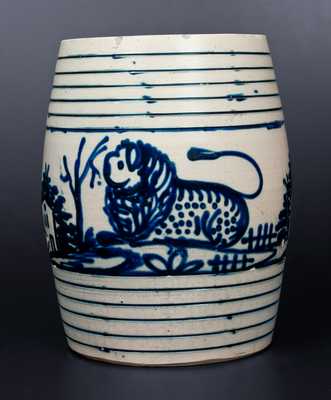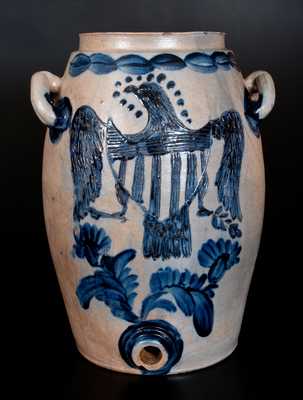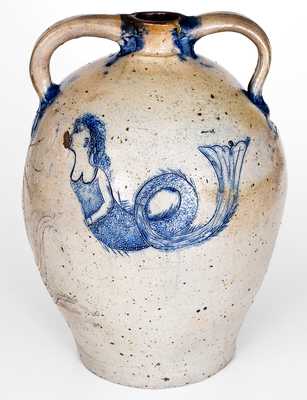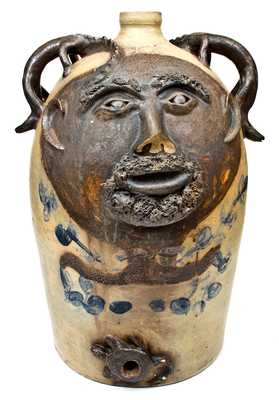Exceedingly Rare and Important Three-Gallon Stoneware Presentation Cooler with Incised Heart-Shaped Foliate Decoration, Inscribed "N. Frost" and "Cornwill Landing / July 27, 1825 / M.C. Bell," Moses Clark Bell, Cornwall, NY, 1825, ovoid jug-form cooler with heavily-tooled shoulder, ribbed handles, and bung hole at base, the body decorated with an incised heart-shaped foliate design surrounding the name "N. Frost". Incised below with the inscription "Cornwill (sic) Landing / July 27 1825 / M.C. Bell". Strong cobalt highlights throughout incising. Additional cobalt brushed around handle terminals and bung area. Moses Clarke Bell was born in Cornwall in 1799, took up the stoneware potter's craft and would ply his trade for roughly thirty years before giving his business over to the Machett family. An early biography of Bell states, "In early manhood [he] served an apprenticeship at the pottery trade ... at Cornwall-on-the-Hudson, and he subsequently engaged in ... brick manufacturing with his brother, Nathan Clarke Bell. The close confinement to which he was subjected during his connection with the pottery ... seriously impaired his eyesight, and when about the age of forty years, while yet in the prime of life, he became totally blind, one of the saddest afflictions to which human flesh is heir. He was a man of remarkable physique and great energy, and was possessed of sterling principles of character, which endeared him to all with whom he was brought in contact." Clarke moved to City Island in the Bronx, New York City, in 1854 and died there ten years later. The presentation name "N. Frost" on the shoulder of this cooler likely refers to Niles Frost, a brewery owner operating fifteen miles south of Cornwall. The majority of Cornwall stoneware objects in existence, made by members of the Bell and Machett families, have simple brushed foliate or floral designs. The form, incising, and inscription on this example, rank it among the finest examples of Cornwall stoneware known. A significant recent discovery. Provenance: A fresh-to-the-market example, which descended in a New York State family. Essentially as-fired condition. Glazed-over area at base where bung hole was lost during the firing. A minor separation line to one handle terminal. A few contact marks to surface, typical of stoneware of this age. H 15 1/2".















